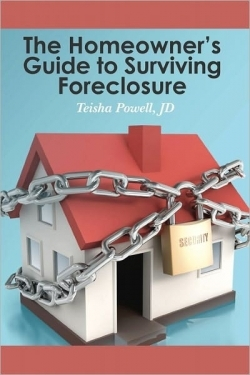It looks like you've stumbled upon a page meant to be read by our code instead of viewed directly. You're probably looking for this page.
The Homeowner's Guide to Surviving Foreclosure
The Homeowner’s Guide to Surviving Foreclosure is written with the economy of an attorney who is accustomed to charging billable hours to financially challenged clients. Author Teisha Powell is an attorney, a former realtor, and a member of the National Association of Consumer Advocates. Her law firm specializes in foreclosure, litigation, and bankruptcy. She knows her stuff. She knows her audience. She doesn’t condescend. She doesn’t fill the text with pointless patter. She simultaneously reassures and informs.
An attitude of advocacy is clear from the outset. While other books in the field are quick to reassure with a pat, “this isn’t your fault,” Powell’s guide begins with an empowering explanation that places blame for the foreclosure debacle on corrupt Wall Street money managers and greedy bankers.
Briefly, she explains that traditional long-term fixed mortgages provided too little profit over too long a time. In order to increase profit by increasing volume, bankers lowered down-payment requirements from 20 percent to 5 percent to 2.5 percent to zero percent. The mantra was, “Let us just give everyone a loan who wants a loan.” People were able to buy a home by using nothing but the available line of credit on their credit cards. According to the author, by 2005, 69 percent of the United States population owned a home. This created a shortage of available homes, a situation that drove up prices. People speculated on the housing market. And they borrowed against their equity to buy luxuries they couldn’t afford. As investment firms saw that the market was becoming saturated, they came up with new schemes. They bought insurance against the inevitable defaults and then guaranteed additional defaults by issuing subprime loans. Finally, they defrayed their risk by pooling the loans together.
Once Powell has whipped her readers into a frenzy over culpability, she helps them overcome their emotions and make a plan. She is like a nurturing but firm mentor who will brook no nonsense. The reader is coerced and cajoled into following Powell’s clear explanations of judicial and nonjudicial default procedures, loan modification, forbearance, hardship qualifications, bankruptcy, deficiency judgment, short sales, and deed in lieu.
Legal advice is augmented by street smarts like these: Stall. Live rent free for as long as possible to save up for the next step. If one’s appeal is denied, let the lender find out on its own. Don’t just sit and wait, negotiate. Hang in there—the government may come up with a new program. Play one bank against another. If there’s no budget for an attorney, file one’s own documents. A very useful appendix provides sample documents that will be helpful to homeowners and essential to library collections.
The Homeowner’s Guide to Surviving Foreclosure offers comfort and advice to the growing number of people facing foreclosure. It provides state-by-state information on foreclosure law as well as instructions for finding the most recent government programs. Readers will find this a very useful book.
Reviewed by
Marilyn Berry
Disclosure: This article is not an endorsement, but a review. The publisher of this book provided free copies of the book and paid a small fee to have their book reviewed by a professional reviewer. Foreword Reviews and Clarion Reviews make no guarantee that the publisher will receive a positive review. Foreword Magazine, Inc. is disclosing this in accordance with the Federal Trade Commission’s 16 CFR, Part 255.
